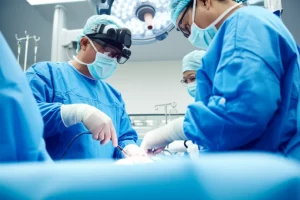Pushing the Limits: Endoscopic Removal of a Giant Stomach Lump in a Teenager
Hello There! Let’s Talk About Something Rare
You know, in the world of medicine, we often encounter things that make us pause and think, “Wow, that’s not something you see every day!” And sometimes, we get to be part of pushing the boundaries of what’s possible, especially when it comes to helping our younger patients. That’s exactly what happened in a recent case we want to tell you about – a story of a giant, unexpected guest in a teenager’s stomach and how we managed to evict it without major surgery.
So, picture this: gastric lipomas. Sounds fancy, right? Basically, they’re benign (non-cancerous) tumors made of fat that grow in the stomach wall. Now, these aren’t super common to begin with, making up less than 1% of all stomach growths. And when you talk about them showing up in kids or teenagers? Exceptionally rare. Even rarer? When they decide to grow into a *giant* size, like over 8 centimeters. Most small ones just hang out, causing no trouble, and we leave them be. But a big one? That’s a different story. They can cause all sorts of headaches – pain, blocking the stomach, bleeding, making you feel sick and vomit. When they get that big and troublesome, we usually have to step in.
The Big Challenge: A Giant Lump in a Young Patient
Traditionally, dealing with these large stomach lumps, especially the giant ones, has meant surgery. You know, opening things up. But surgery, while effective, comes with its own set of challenges, recovery time, and for a young person, maybe some unwanted scarring. In recent years, though, we’ve gotten pretty good with endoscopic resection in adults – using flexible tubes with cameras and tools to remove things from inside the body, like through the mouth. It’s way less invasive. The catch? Doing this for a giant lump, particularly one that’s broad-based (meaning it doesn’t have a stalk, making it trickier to grab and cut), and doing it in a teenager? That wasn’t really documented as a successful approach. Until now.
We recently saw a 17-year-old girl who was having a rough time for about three months. She felt bloated and had indigestion after eating, and was vomiting pretty regularly. Nothing else seemed out of the ordinary with her. When we did a gastroscopy (that’s where we send a camera down into the stomach), we found it – a huge, smooth, soft mass in the body of her stomach. It was about 7 by 8 centimeters and, when her stomach wasn’t full, it was actually blocking the passage! When we inflated her stomach, we could see it was broad-based, not hanging on a little stem.

To figure out exactly what we were dealing with and make sure it wasn’t something nasty, we used endoscopic ultrasound (EUS) and a CT scan. The EUS showed a bright, well-defined mass under the stomach lining, looking very much like fat. The CT scan confirmed it was a homogeneous fat-density mass, confined to the stomach wall, with no signs of it spreading or involving lymph nodes. All signs pointed to a benign lipoma. But a giant one!
Making a Bold Decision: Going Endoscopic
Now came the big decision. We had a chat, a multidisciplinary discussion involving surgeons and anesthesiologists. Surgery was the traditional route, but we considered the patient. She was young, wanted to avoid a big scar, and really hoped to keep her stomach working just as it should. Plus, our detailed imaging suggested the tumor was in a good spot for an endoscopic approach – it was submucosal (under the lining), growing into the stomach space, and didn’t seem to be invading deep or spreading.
So, we decided to go for it: Endoscopic Submucosal Dissection (ESD). This is a technique where you inject fluid under the lesion to lift it, and then carefully cut it away from the stomach wall using special endoscopic tools. It’s delicate work, especially with a broad-based, giant mass like this one.
The Procedure: A Delicate Dance
During the ESD, we injected a blue saline solution under the mass to help lift it and make the dissection easier. We meticulously cut around and under the lesion, paying close attention to blood vessels. There were challenges, of course – some bleeding, and visual obstruction from the fat tissue as we used cautery. But we managed to work through them and successfully remove the entire tumor.
Here’s where it gets interesting. This thing was *giant*. Too big to just pull out whole through the esophagus. So, what did we do? We fragmented it! We used snares and electrocoagulation to cut the mass into about 30 smaller pieces, each roughly 2-3 cm. Then, we removed these pieces one by one, orally. It was a bit like a delicate, internal puzzle, but we got it all out. The wound bed where the tumor was attached was clean and looked good.

Recovery and What We Learned
After the procedure, we kept a close eye on our patient. The wound was large, too big to close with clips, but thankfully, she didn’t show any signs of perforation (a hole). We monitored her for 72 hours, checking her vital signs and abdomen. She recovered beautifully, started eating gradually, and was discharged in stable condition without any complications. Later, the histopathology confirmed it was indeed a benign gastric lipoma, just as we suspected.
This case is a pretty big deal. Gastric lipomas in young people are rare, and a giant one (>8cm) is even rarer. Successfully removing a giant, broad-based one endoscopically in an adolescent? That hadn’t been reported before. Previous attempts at endoscopic removal in kids with giant lipomas had failed, often leading to surgery.
This case, one of only a handful of giant gastric lipomas reported in patients 18 or younger, shows that endoscopic submucosal dissection *is* feasible for carefully selected adolescents, even with challenging broad-based lesions. It meant our patient avoided major surgery, kept her stomach function, and had no immediate complications. That’s a huge win for her and her family.

Looking Ahead: The Future of Minimally Invasive Options
So, what does this mean for others? For small, symptom-free lipomas, we’ll keep watching them. For bigger, troublesome ones, surgery is still a solid option, especially for giant ones. But this case tells us that for *selected* giant lipomas, particularly those that look benign on imaging and are in a favorable location, endoscopic resection could be a fantastic alternative, even for adolescents.
It really highlights how crucial detailed preoperative imaging (CT and EUS) is, along with a multidisciplinary team discussion. We need to be sure it’s benign and that the anatomy is right for an endoscopic approach. While we didn’t do a biopsy beforehand in this specific case (based on very strong imaging evidence and consensus, which is a limitation we acknowledge!), preoperative biopsy is generally the gold standard to confirm benignity and avoid any risks if it were something else.
This case encourages us to keep exploring and expanding minimally invasive options in pediatric gastroenterology. Avoiding surgery means less morbidity and preserving normal function, which is incredibly important for young patients. Of course, this is just one case, and we need more studies and long-term follow-up to confirm these outcomes and figure out exactly which patients are the best candidates for this approach. But for now, it’s a promising step forward, showing that with the right expertise and careful planning, we can tackle even giant challenges endoscopically!
Source: Springer







